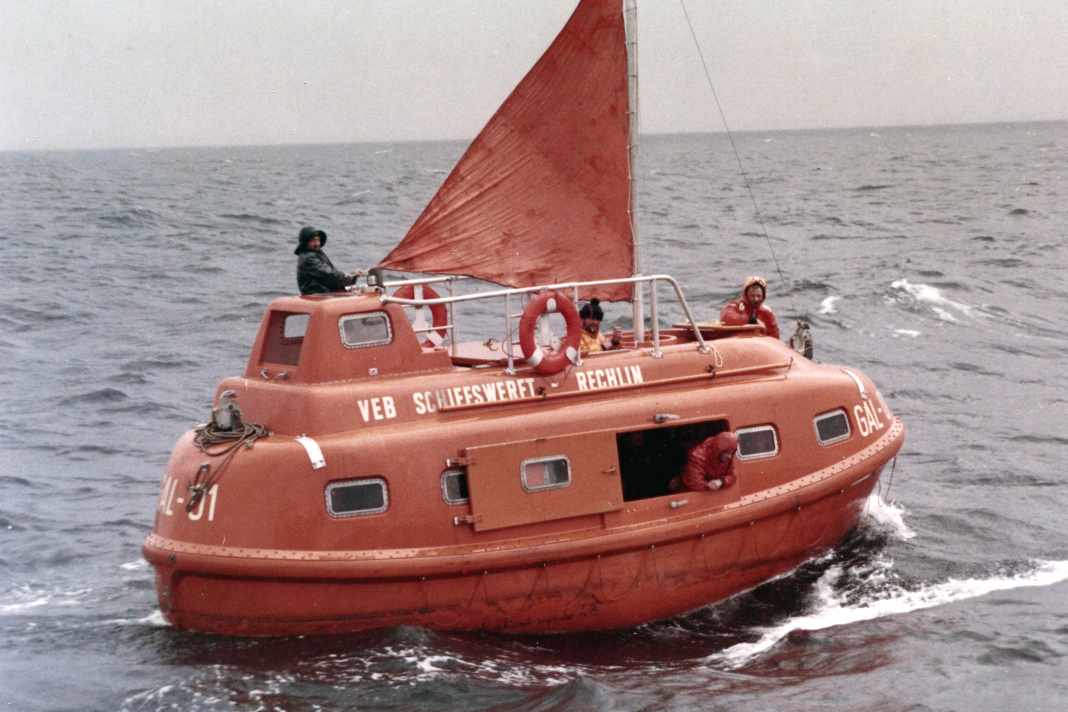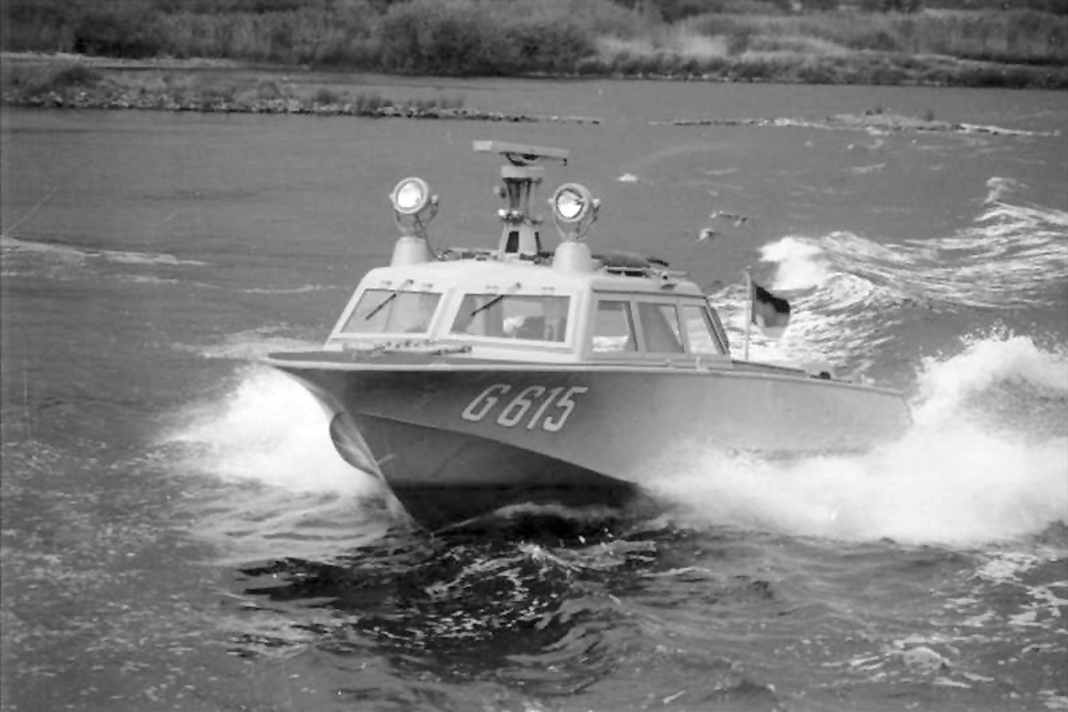





The small municipality of Rechlin on the south bank of the Müritz, with a population of just over 2,000, was a popular starting point for boat trips in the GDR era and is still known to many tourists today as a water sports paradise. But before the region focussed on tourism after reunification, it was also an industrial location. For over 40 years, the town's name was synonymous with the boats that originated here far beyond the borders of the country. After the Second World War, VEB (state-owned enterprise) Schiffswerft Rechlin was established on the site of the largest central testing centre of the German Air Force, which was to develop into the largest employer in the region over the following decades.
You can find more exciting museums here:
Rechlin shipyard: the largest employer on the Müritz
Until the beginning of the 1990s, thousands of pleasure craft, lifeboats, marine engineering systems for large ships and military boats were designed and manufactured here. "It was a huge shipyard. Busloads of workers from all over the surrounding area arrived here every day," says qualified shipbuilder Thorsten Heinrichs, who was employed here in the last years of the shipyard until 1992. "The workers called our construction department the 'sloth enclosure'," he says with a grin. "For the workers, the end of the shipyard after reunification was a disaster. And for the region too. There was nothing else here. People were forced to move away and look for work elsewhere." Heinrichs himself set up his own company after reunification, which still manufactures equipment for lifeboats, among other things. His time at the Rechlin shipyard laid the foundation for this. This is certainly one of the reasons why he now offers voluntary guided tours of the former shipyard site, where almost half a century of shipyard history is brought to life. The Aviation Museum tells the story of a time when hundreds of boats were launched here every week. From leisure sailing boats to torpedo speedboats. Some examples, such as a former GDR border guard boat GSB 075 and a small torpedo speedboat (KTS), can be viewed today in the museum's outdoor area.
Military shipbuilding
In the 1970s, the KTS with the NATO code "Libelle" was one of the fastest boats in the Baltic Sea, reaching top speeds of more than 100 kilometres per hour.

Once a month, the ship is opened to interested visitors and former crew members, who maintain the ship on a voluntary basis, talk about their time on board the "Libelle". Thorsten Heinrichs recalls an anecdote from one such "history lesson": "A former commander told us about a test drive with a newly delivered KTS. The minimum requirement was 90 km/h, but the ship was a good 20 km/h below that. The shipyard spent over a month looking for the fault. Until it was discovered by chance that one of the side hatches for the exhaust had been cut out one centimetre too small. That one centimetre made all the difference." But apart from this small outlier, the KTS was considered "state of the art" and absolutely reliable. From 1974, a total of 30 of the almost 19-metre-long hulls in fully welded aluminium construction were delivered to the Peene shipyard in Wolgast for motorisation and armament. A major challenge was the almost 150-kilometre overland transport on the then still very narrow and poorly constructed country roads and local thoroughfares.

Alongside the People's Army, the GDR Border Guard was one of the main customers for boats from Rechlin. However, there were a few hurdles to overcome before the first type 066 border security boats could be delivered (116 units by 1973). As there was a lack of effective propulsion systems and the company's own development attempts failed, Volvo Penta engines were grudgingly imported from Sweden. And this was for a boat that was to be used on the state border with West Germany, of all places. From 1977, the 075 border security boat in glass fibre-reinforced plastic replaced the aluminium type, in which Soviet-design ZIL engines replaced the expensive Western imports.



Many of the military boats were also exported to the USSR and Hungary and were used for border security on the Danube. After reunification, many of the former border patrol and rescue and security boats (RuSB) were taken over by the Federal Border Guard, the state police forces of the federal states and the THW.
The Rechlin shipyard specialised in lifeboats
As early as 1960, so many boats were being produced in Rechlin that a switch was made from rivet construction to inert gas welding. At the end of the 1960s - when the production of glass fibre reinforced plastic was still in its infancy worldwide - the Rechlin shipyard was one of the first shipyards in Europe to work with the new material. The workers involved were actually carpenters and had no idea what they were dealing with. Within just one year, a "plastics department" was set up and the necessary expertise acquired.
The workers confronted with the new GRP material were actually carpenters and had no idea what they were dealing with
The expensive negative moulds required for series production were elaborately produced in the shipyard's own model construction department. In this way, more than 50,000 life raft containers left the shipyard by 1989. In 1963, the Rechlin shipyard was regarded as a specialised lifeboat company. All GDR lifeboats came from here. At the beginning of the 1980s, the introduction of the completely enclosed and self-righting lifeboats, the Rechlin GAL series, ushered in a new era in lifeboat construction and significantly improved the chances of survival for injured seamen. Shortly before reunification, free-fall lifeboats were also developed at the Rechlin shipyard. Following the failed privatisation of the shipyard, the design documents and moulds for the lifeboats were sold to rival companies in the former West Germany.
Consumer goods production: Recreational boat building in the GDR
In addition to the military and border guards, the Gesellschaft für Sport und Technik (GST) was a major customer for lifeboats and diving pontoons. In 1974, the Rechlin shipyard was commissioned by the GST to develop a rowing and sailing cutter for ten people plus helmsman. Young people were to learn the basics for future naval service here. In 1976, the "Zesenkutter ZK-10" went into series production. By 1980, 223 of these cutters had been built. Rechlin also produced pleasure boats for the leisure sector. Like all industrial companies in the GDR, the Rechlin shipyard was also required to produce consumer goods. Over 4,000 pleasure craft, from dinghies to larger motorboats, were launched at the Müritz. These included the Habicht, Kranich and Viola motorboats presented at the 1960 Leipzig Trade Fair. In the museum's exhibition room, classic boat enthusiasts will find gems such as the "Wellenbinder", which has achieved cult status today, the "Volkspaddelboot" and a "camping dinghy" that could be transported on the roof of a car. Since the Wall was built in 1961, recreational boats were banned along the entire GDR coast. Even air mattresses were considered suspicious by border troops and a possible means of escape. Even in GDR times, the region around the Müritz therefore developed into the water sports paradise of the East. The demand was there. However, the private water sports sector hardly played a role in the GDR's socialist economic plan and boat engines were not included in the five-year plan.
The private water sports sector hardly played a role in the GDR's socialist economic plan; boat motors were not included in the five-year plan
This meant that converted Wartburg and Trabbi engines were the norm in GDR sports boats. Motorboats for private use were luxury goods and unaffordable for the average wage earner. What's more, you had to wait years for them.
Necessity is the mother of invention
As in many other areas, the shortage awakened the inventive spirit of some water sports enthusiasts in the GDR. Many private motorboats were welded together without further ado. This resulted in original home-made designs, such as the "Trabitanic" from 1987 on display in the museum grounds. Two discarded Trabbi roofs served as the superstructure for the flat-bottomed steel boat. The increasing diversification of the product range due to the mandatory production of consumer goods posed massive quality problems for many companies, including the Rechlin shipyard. This was because the companies were also obliged to manufacture non-product products "for private use to increase the supply level of the population". This took on grotesque proportions in some cases: Shipyards supplied bottle openers or garden furniture, an explosives factory supplied fly swatters. The Rechlin shipyard had to produce camping trailers and household accessories such as wardrobes and doormats in addition to its torpedo speedboats, border guards and lifeboats.
An invention from Rechlin saves lives
One order, however, led to an invention that the Rechlin team is particularly proud of to this day: After the tragic sinking of the freighter "Fiete Schulze" in 1967, in which thirteen sailors froze to death in the icy Bay of Biscay, the shipyard was commissioned to develop a survival suit in which sailors could survive for several hours even in water temperatures close to freezing point. In 1979, the GDR merchant navy introduced the RA-S suit developed in Rechlin four years before the amendment to the Safety at Sea Convention (SOLAS, 1974) as mandatory equipment for all its merchant ships to protect crew members. Today, the protective suit is standard equipment for every sailor at sea worldwide. E At the end of the 1980s, production at the Rechlin shipyard was at its peak with over 1,200 employees and an enormous product range. Shortly before the Berlin Wall fell, the foundation stone was laid for a new production hall in which mine defence boats were to be built. It was never used. When the Wall came down, the order was cancelled with immediate effect. Within a very short space of time, hundreds of people lost their jobs and left their homes. The population fell dramatically and the average age rose sharply. A traditional company that had produced over 22,500 boats in 40 years disappeared from the scene. But thanks to the commitment of many volunteers from two associations, the chequered history of the shipyard and the people who lived and worked here is being kept alive.
Contact: Aviation Museum Rechlin e.V.
Am Claassee 1, 17248 Rechlin
Opening hours:
February-March daily 10:00 - 16:00
April-October daily 10:00-17:00

